Folic acid supplementation during preconception period in sub-Saharan African countries: A systematic review and meta-analysis
- PMID: 39888921
- PMCID: PMC11785287
- DOI: 10.1371/journal.pone.0318422
Folic acid supplementation during preconception period in sub-Saharan African countries: A systematic review and meta-analysis
Abstract
Introduction: Neural tube defects (NTDs) are serious congenital anomalies of the central nervous system caused by disruptions in early embryonic development. The prevalence is about twice as common in low- and middle-income countries and more prevalent in sub-Saharan Africa. Folic acid deficiency is a major risk factor and common during pregnancy. However, limited research on preconception folic acid supplementation in this region highlights the need for systematic reviews and targeted interventions to improve maternal and fetal health.
Methods: We conducted a systematic literature search in EMBASE, MEDLINE, Scopus, CINAHL, Google Scholar, and Google for studies on the proportion of folic acid supplementation during the preconception period, covering publications up to January 2024. Study quality was assessed using the Newcastle-Ottawa Scale. Heterogeneity was evaluated with Cochrane Q and I2 statistics, and small study effects were tested with Egger's test at a 5% significance level. The certainty of evidence was assessed using the GRADE approach. A random-effects model was used to estimate the pooled proportion of FA supplementation during the preconception period in sub-Saharan African countries.
Result: This systematic review included 28 studies with a total of 12,562 participants. The highest (45.2%) and lowest (1.9%) proportion of folic acid supplementation during preconception period were recorded in the southern and Amhara regions of Ethiopia, respectively. The estimated pooled proportion of folic acid supplementation among women in Sub-Saharan Africa (SSA) during preconception period was (14.10%; 95% CI: 11.22-16.98) with significant heterogeneity between studies (I2 = 97.71%, p = 0.001). In sub-group analysis based on corresponding countries the highest estimated folic acid supplementation proportion during preconception period was found in studies conducted in Kenya ((22%; 95% CI: 19%-25%), I2 = 97.7%), followed by studies conducted in Ghana (20%; 95% CI: 7%-33%), I2 = 96.9%). The majority of the studies included in the analysis are of high quality, with quality scores ranging from 7 to 8. The certainty of evidence was assessed using the GRADE approach, resulting in a low overall rating.
Conclusion: The results of this systematic review and meta-analysis indicated that folic acid supplementation during preconception period is significantly low among mothers in sub-Saharan African countries, despite being one of the best approaches to improve birth outcomes. Therefore, healthcare organizations, governments, policymakers, and other stakeholders involved in folic acid supplementation must collaborate on developing strategies to improve its uptake during the preconception period.
Copyright: © 2025 Aweke et al. This is an open access article distributed under the terms of the Creative Commons Attribution License, which permits unrestricted use, distribution, and reproduction in any medium, provided the original author and source are credited.
Conflict of interest statement
The authors have declared that no competing interests exist.
Figures

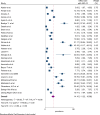
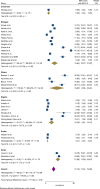
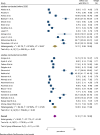
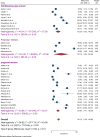
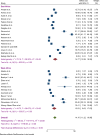



Similar articles
-
Folic acid supplementation and malaria susceptibility and severity among people taking antifolate antimalarial drugs in endemic areas.Cochrane Database Syst Rev. 2022 Feb 1;2(2022):CD014217. doi: 10.1002/14651858.CD014217. Cochrane Database Syst Rev. 2022. PMID: 36321557 Free PMC article.
-
Folic acid supplementation during the preconception period: A systematic review and meta-analysis.Prev Med. 2018 Sep;114:1-17. doi: 10.1016/j.ypmed.2018.05.023. Epub 2018 May 23. Prev Med. 2018. PMID: 29802877
-
Effects of preconception care and periconception interventions on maternal nutritional status and birth outcomes in low- and middle-income countries: A systematic review.Campbell Syst Rev. 2021 May 5;17(2):e1156. doi: 10.1002/cl2.1156. eCollection 2021 Jun. Campbell Syst Rev. 2021. PMID: 37131925 Free PMC article. Review.
-
Fortification of wheat and maize flour with folic acid for population health outcomes.Cochrane Database Syst Rev. 2019 Jul 1;7(7):CD012150. doi: 10.1002/14651858.CD012150.pub2. Cochrane Database Syst Rev. 2019. PMID: 31257574 Free PMC article.
-
Folic acid to reduce neonatal mortality from neural tube disorders.Int J Epidemiol. 2010 Apr;39 Suppl 1(Suppl 1):i110-21. doi: 10.1093/ije/dyq028. Int J Epidemiol. 2010. PMID: 20348114 Free PMC article. Review.
Cited by
-
Low Dietary Folate Increases Developmental Delays in the Litters of Mthfr677TT Mice.Nutrients. 2025 Aug 1;17(15):2536. doi: 10.3390/nu17152536. Nutrients. 2025. PMID: 40806120 Free PMC article.
References
-
- Mohmmed RGA. DETERMINATION OF RISK FACTORS ASSOCIATED WITH NEURAL TUBE DEFECTS IN INFANTS. SADI Journal of Nursing and Pharmaceuticals. 2022;9(3):50–60.
Publication types
MeSH terms
Substances
LinkOut - more resources
Full Text Sources
Medical
Research Materials

